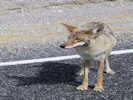 Eastern Mojave Vegetation
Eastern Mojave Vegetation
Tom Schweich
 Eastern Mojave Vegetation
Eastern Mojave Vegetation
| Badwater Road - Death Valley |
|
Tom Schweich |

|
(No Preface) | |
|
Other articles:
|
Junction: California Highway 190 | |
| Golden Canyon Rd | ||
|
Literature Cited:
Locations: Gower Gulch. |
Gower Gulch | |
| Mushroom Rock | ||
| Artist Drive (north exit) | ||
|
Other articles:
|
North Junction: West Wide Road | |
| Artist Drive (south entrance) | ||
| Natural Bridge Road | ||
|
Literature Cited:
Other articles:
Locations: Badwater Basin. |
Badwater Basin to the west.
About 1.5 km to the west, a 186-m-long core, known as DV93-1, was drilled in the interbedded salt and mud of Badwater Basin. The cored sediments contain a 200 k.y. record of closed-basin environments and paleoclimates ranging from dry mudflats, similar to the modern floor of Death Valley, to temperate-climate, deep perennial lakes. The 200 k.y. paleoclimate record of Death Valley is dominated by two dry and/or warm and wet/cold cycles that occurred on a 100 k.y. time scale. Of particular importance are the major lacustrine phases at 10 to 35 ka and 120 to 186 ka, which represent markedly colder and wetter conditions than those in modern Death Valley. Of the two perennial lake periods, the penultimate period had deeper and far longer lasting lakes than the last glacial lake (Lowenstein, et al., 1999). Reports of Bacteria and Archaea cultured from halite crystals, some more than 250 m.y. old, are at the center of the debate about longterm survival of microorganisms on Earth and elsewhere in the solar system. Schubert, et al. (2009) report non-spore-forming halophilic Archaea cultured from 22–34 k.y. old halite from core DV93-1. Reproducible growth of non-spore-forming halophilic Archaea from ancient halite indicates that dormancy is not required for long-term survival. Rather, miniaturized prokaryotes may be better suited to long-term survival because their low level metabolic activity and small size preserve the finite nutrients available in a fluid inclusion. Glycerol, produced by associated Dunaliella cells, may provide the energy required for these prokaryotes to maintain metabolic processes in fluid inclusions for extended periods. | |
|
Literature Cited:
Other articles:
Locations: Badwater. |
At Badwater and Mormon Point, the detachments and hanging walls of the Black Mountains fault zone is exposed above the valley floor (Hayman, et al., 2003). | |
| Copper Canyon | ||
|
Literature Cited:
Locations: Mormon Point. |
Mormon Point At Mormon Point and Badwater, the detachments and hanging walls of the Black Mountains fault zone is exposed above the valley floor (Hayman, et al., 2003). | |
| South Mormon Point | ||
|
Other articles:
|
South Junction: West Wide Road | |
 Coyote begs for food along Badwater Road. Coyote begs for food along Badwater Road.
|
Coyote begs for food along Badwater Road. | |
|
Other articles:
|
Junction:
| |
| If you have a question or a comment you may write to me at: tomas@schweich.com I sometimes post interesting questions in my FAQ, but I never disclose your full name or address. |
Date and time this article was prepared: 5/12/2025 2:42:01 PM |